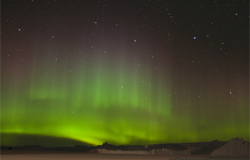Where to See the Northern Lights
GENERAL AREA
Location, location, location: The Northern Lights are visible at their best in a ring-shaped region centered around the Earth's North magnetic pole (image courtesy of Geophysical Institute/University of Alaska Fairbanks):

As is apparent, there are a number of places to see the lights in the Northern Hemisphere: Iceland and Northern parts of Finland, Sweden and Norway in Europe; Southern part of Greenland, Alaska and some places in Canada in North America; Northern parts of Russia. Locations of the Southern Lights are mostly in inhospitable Antarctica and sometimes in New Zealand, Tasmania, Argentina and Chile.
Therefore, you need to go to a place on the aurora ring or close to it to get a chance at seeing the lights; your chosen location should be on the ring or close to it, not in the center or inside the ring.
To further complicate things, on the map below (or on the one above) you will see two rings. The inner ring is the most important one – in places on this ring you will see the full extent of the lights directly above you; the outer ring is the range to see the lights at the horizon:

BEST LOCATIONS
Based on the maps below, here is a list of best locations to see the Norhtern Lights (links to the travel profile of each location on travel website Wikivoyage):
Best Locations in Europe
- Tromso, Norway
- Alta, Norway
- Jukkasjarvi, Sweden
- Kilpisjarvi, Finland
- Inari, Finland
- Utsjoki, Finland
- Kola Peninsula, Russia
Best Locations in the North Atlantic Islands
Best Locations in North America
Obviously you can choose many other locations to try and spot the lights, but remember: the farther away you get from the inner ring in the picture above, the lower the odds you get to see a good show (or anything at all). If you get outside the outer ring, your odds are even lower.
When choosing a location there will be a number of factors the consider. The most important one is being as close as possible to the action, on the aurora ring presented above. You will also want to consider weather conditions, discussed in our next chapter: this will not only impact your aurora experience, but will influence your enjoyment of the entire trip; you will possibly also want a location that's closer to where you live; finally, research your chosen location(s) first, as you will want to find activities for daytime as well, not just at night when the aurora happens.
Our recommendation for a good location in Europe is the Norwegian city of Tromso (sometimes called the Northern Lights Capital of the World or of Europe by clever marketing specialists). Apparently there's a 90%+ chance of seeing the lights in Tromso if other conditions presented in this guide are met. Bonus: Tromso, the largest city in Northern Scandinavia, is very charming and there's stuff to do and see during the day as well. Check out the page of the Tromso Tourism Office for activities, sights and accommodation in town.
LIGHT POLLUTION
You need darkness to properly see the aurora as city lights will drown it out and you'll see far less or nothing at all. Keep in mind that light pollution is trikcy; even though you might think it's dark enough outside and there's no source of light in sight, ambient light from nearby towns or villages will still impact your experience. Get as far away from towns and villages as possible; the larger the nearby city or settlement, the farther your need to go.
Rent a car to drive out of the city or get on one of the many organized tours available. An don't just go a couple of miles outside towns and cities - you need to leave civilization farther behind if you want a good show. Finally, make sure you're not close to a road, where light from passing vehicles may affect your experience.
ONE LOCATION OR MORE?
If the conditions are right you can see the aurora for nights in a row from the same location without a problem. The aurora is not a fixed phenomenon and the shapes changes constantly; the light show will be mesmerizing and different every night. One option is to find a good location and stick with it.
This being said, there are plenty of arguments to be made for different locations for every night of your trip. Even if all conditions are right, you may want changes of scenery for better pictures or a nicer viewing experience. Even more importantly, conditions may not be right and you may need to travel around to find a good spot (i.e. without clouds covering the sky, etc).
If you have your own transportation, it pays to travel around. If not, you may choose different tours that will take you to different places. Some tours will take you to one spot and that's it (not a bad option if the conditions are right and they have nice bonuses such as a fire-warmed tent); others may drive for hours, even crossing national borders (bring your passport!), hunting for the best. You may want to take into account your personal preferences as well (would you like to ride a bus for hours every night for a shot at the best experience or would you be more comfortable sticking with one spot?). From our experience, even though driving around constantly seems more efficient, a single spot will also work nicely if everything else is just right.
Once you've settled for a destination, you need to take into accont another important issue. Continue with the next chapter: Weather - How weather conditions affect Northern Lights

